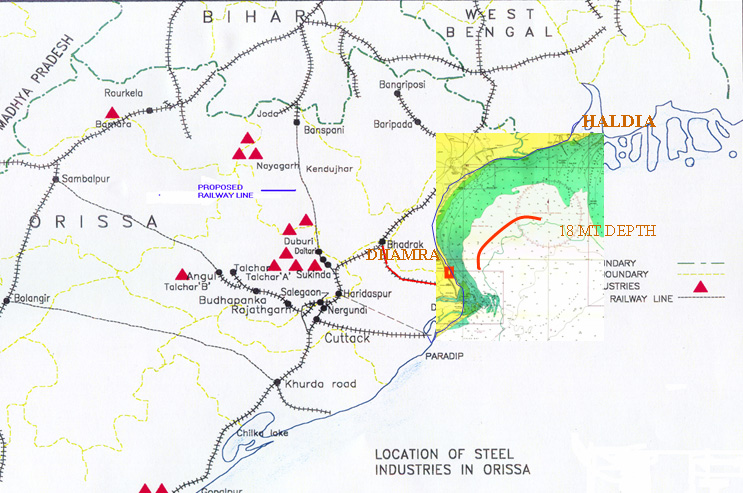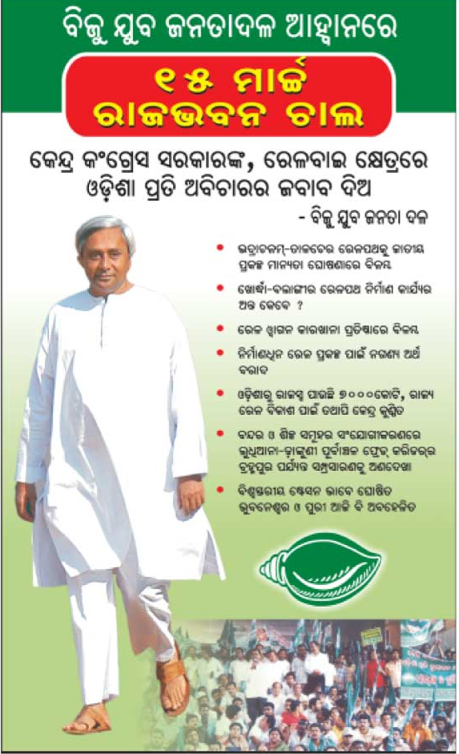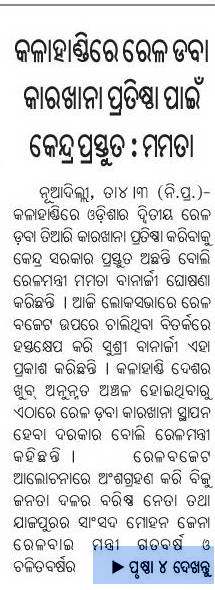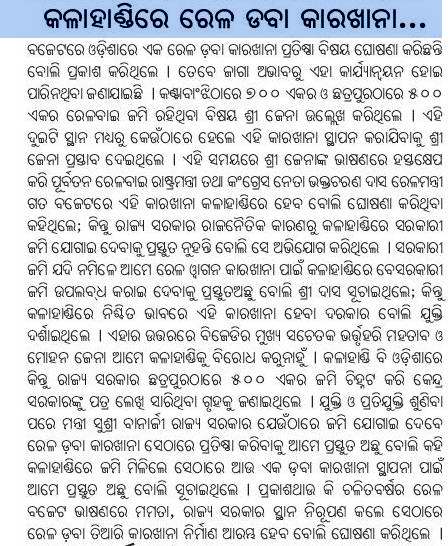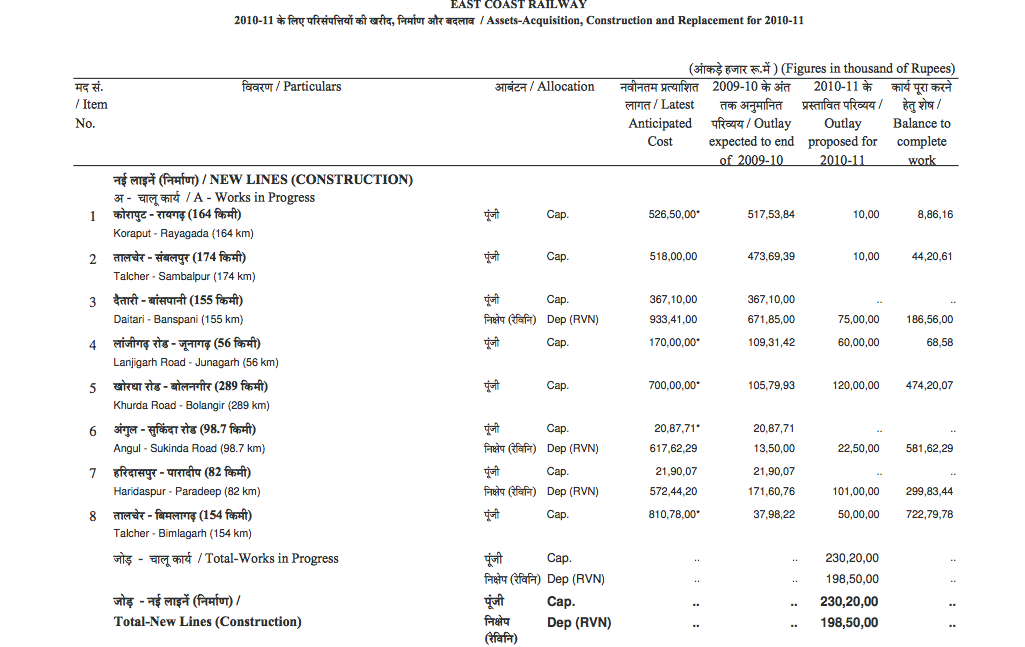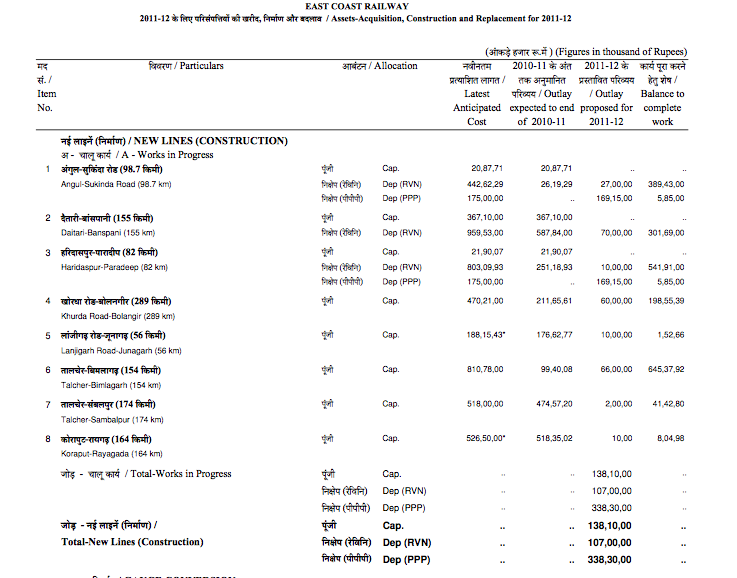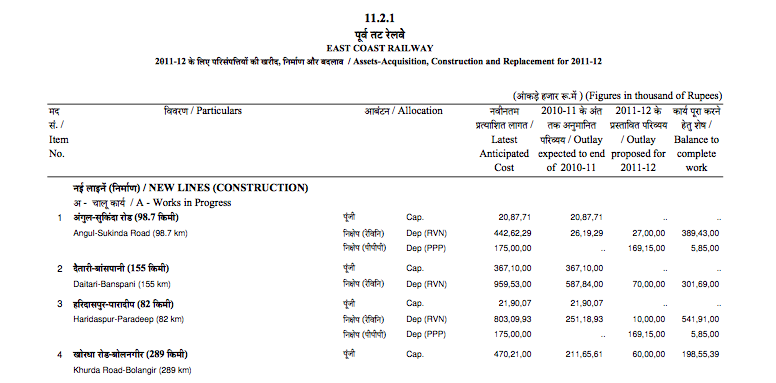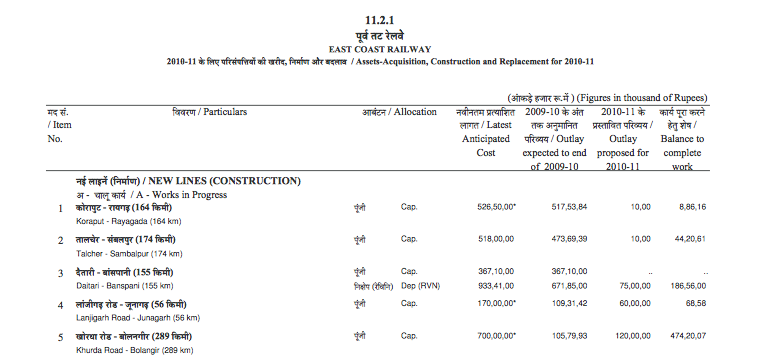See http://www.indianrailways.gov.in/railwayboard/uploads/directorate/finance_budget/RailBudget_11-12/RailBudget_2011-12.pdf for the budget speech.
See http://www.indianrailways.gov.in/view_section.jsp?lang=0&id=0,1,304,366,539,1056 for the pink book.
The new trains, extensions and frequency increases that may have stops in Odisha are:
- Sealdah – Puri non AC Duronto (tri-weekly) [From Feb 2012]
- Vivek Express: Dibrugarh- Thiruvanthapuram-Kanniyakumari Express (weekly) via Kokrajhar [From Nov 2011]
- Vivek Express: Howrah-Mangalore Express (Weekly) via Palghat [New connectivity] [From Feb 2012]
- Kavi Guru Expres: Howrah-Porbander Express (weekly) [From Nov 2011]
- Rajya Rani Express: Jharsuguda – Bhubaneswar Express (tri-weekly) [From Nov 2011]
- Visakhapatnam- Koraput Intercity Express (5 days a week) via Vizianagram [Much needed] [From March 2012; but only 2 days a week]
- Howrah-Secunderabad Express(weekly) via Kharagpur [From Feb 2012]
- Hyderabad- Darbhanga Express (weekly) via Muri-Jharsuguda-Nagpur [New connectivity] [From July 7 2011]
- Howrah – Tirupati Express (weekly) [Summer special, regular from July 2011]
- Puri-Shalimar Express(weekly) [Summer special, regular from July 2011]
- Ranchi- Pune Express (bi-weekly) via Bilaspur [From Nov 16 2011]
- Shalimar-Udaipur Express(weekly) via Katni, Kota [via Rourkela; new conectivity] [From Feb 2012]
- Howrah-Mysore Express (weekly)
via Gondia [New connectivity] [From Feb 2012]
- Digha-Visakhapatnam Express(weekly) [From Feb 2012]
- Puri-Gandhidham Express(weekly) via Durg [New connectivity] [From Nov 2011]
- Howrah-Visakhapatnam Express(weekly) [Summer special, regular from July 2011]
- Digha-Puri Express (weekly) [From Feb 2012]
- Kharagpur-Viluppuram Express (weekly) via Vellore [Increases connectivity] [From Feb 2012]
- Purulia –Viluppuram Express (weekly) via Midnapore, Kharagpur, Vellore [Increases connectivity] [From April 13 2012]
- Howrah-Nanded Express (weekly) [New connectivity] [From Feb 2012]
- Kendujhargarh- Bhubaneswar Fast Passenger ( 5 days a week) [Much needed] [From Nov 2011]
- Koraput- Bolangir-Sambalpur Passenger (daily) [Needed] [From March 2012]
- Baripada-Bangariposi DEMU [New connectivity] [From Nov 2011]
- Sambalpur- Nizamabad Express to Nanded (18309/18310) [New connectivity] [From July 1 2011]
- Rourkela- Bhubaneswar Express from 6 days to daily (18105/18106) [Needed] [From July 1 2011]
* Update (Not in the budget): Jammu Tawi-Hatia Express extended to Rourkela. [From Nov 12 2011] [New connectivity, Needed]
* Update (Not in this year’s budget): Bhubaneswar – Baripada Express extended to Bangiriposi [From March 2012] [Needed]
The items in red are ones that appear interesting to me. The reason they are interesting to me are given in square brackets. In particular, the budget brings new connectivity (from Bhubaneswar) to Mangalore, Calicut, Gandhidham and Mysore; (from Rourkela & Sambalpur) to Nanded; (from Rourkela & Jharsuguda) to Mysore and many en-route stations (possibly Hyderabad); the much needed VSKP-Koraput intercity express; and new connectivity (from ROU and JSG) to Hyderabad.
Now we go over the budget speech and extract all Odisha related parts from it.
6. … During this year, we have met industry leaders, Chambers of Commerce and Industry to encourage investment in the specified areas of infrastructure, rolling-stock or service provision. Railways will provide economic share to our partners for such endeavours. With this objective, railways have developed several business-oriented policies for the first time. Some of these policy initiatives are:-
- i. Railways’ Infrastructure for Industry Initiative (R3i)
- ii. Private Freight Terminal (PFT)
- iii. Special Freight Train Operators (SFTO)
- iv. Automobile Freight Train Operators (AFTO)
- v. Automobile and Ancillary Hubs
- vi. Kisan Vision (Cold Chains) vii. New Catering Policy viii. Rail Connectivity to Coal and Iron ore mines (R2CI)
13. Railways are already executing works either departmentally or through PPP/JV at Budge Budge, Dankuni, Naopara, Anara, Tindharia, New Cooch Behar, Kharagpur, Haldia, Guwahati and Kazipet. Work on the wagon factory in Orissa will also be taken up once the site is finalized.
25. I propose to set up more mechanized laundries for improving the quality of linen in trains at Nagpur, Chandigarh and Bhopal, in addition to Wadibunder, Tikiyapara, Kamakhya, Secunderabad, Kacheguda, Indore, Lucknow, Banaras, Samastipur, Sealdah, Tatanagar, Danapur, Bikaner, Bilaspur, Durg, Hatia, Chennai, Mumbai and Ahmedabad, where they are commissioned or are being set up. Proposals for laundries at Vishakhapatnam, Bhubaneshwar, Puri, Gwalior, Manduadih, Gorakhpur, Lucknow, New Jalpaiguri, Jammu, Delhi, Jaipur, Jodhpur, Tirupati, Ernakulam, Thiruvananthapuram, Hubli, Bengaluru, Yashwantpur, Jabalpur, Allahabad, Mau, Amethi and Kota are also under examination.
28. Madam Speaker, we had added only 10,677 km of new lines since independence. I had announced an ambitious target of 1,000 km of new lines in 2010-11. This is in contrast to average addition of 180 km annually. In the current year, we may do over 700 km, falling short of the target. But this would be almost double of the highest ever performance in any single year. Unless we set our targets high, we cannot realize the goals of Vision 2020. The hon’ble members will be happy to know that railways will be achieving its target of 800 km for gauge conversion, 700 km for doubling and 1,000 km of electrification.
Annual Plan 2011-12
30. Madam, the Annual Plan for the year 2011-12 has been proposed at `57,630 cr which is the highest ever plan investment by the railways in a single year. The Plan is proposed to be financed through GBS of `20,000 cr, diesel cess of `1041 cr, internal resources of `14,219 cr, market borrowings of `20,594 cr through Indian Railway Finance Corporation (IRFC), considering its past excellent performance in the financial market. Normally IRFC raises between `9,000-10,000 cr annually for leasing of rolling stock. Next year, an additional amount of `10,000 cr will be raised through tax free bonds for financing select capacity enhancement works. Railways will ensure servicing this debt of tax-free bonds. Further, external source of financing through PPP, WIS etc is expected to yield `1,776 cr.
33. In the last budget I had announced updation of surveys for 114 socially desirable new lines. Out of this 94 will be completed by March, 2011 and the remaining by December, 2011. I propose to take up construction of these lines in the 12th five year plan since this budget year is the terminal year of the 11th plan. Our dream is to bring about a social revolution through rail connectivity. We need political freedom along with economic freedom that will usher in prosperity for our millions of countrymen, more especially to the common man.
34. Madam, we have proposed to create a fund to implement the socially desirable projects during the 12th Plan. Under the umbrella of this non-lapsable fund, not only will the pending socially desirable lines be completed, but many other similar new line projects would also be taken up. The scheme is being named, Pradhan Mantri Rail Vikas Yojana. I am extremely thankful to the hon’ble Prime Minister for his support and guidance.
36. Railways are already executing 19 projects in the similar difficult and underdeveloped areas in the States of Orissa, Jharkhand, Chattisgarh, Bihar and Maharashtra and I propose to increase the allocation to these projects to `771 cr.
45. I am now making an offer that whichever state ensures trouble-free train running for the whole year, shall be given two new trains and two projects as a special package.
50. Upgradation of stations would provide safe drinking water, pay & use toilets, high-level platforms, better accessibility for the physically challenged among many other facilities at these stations. I would like to assure all the hon’ble members that all the suggestion for Adarsh stations given by them have been included in the following list of 236 stations. I will be happy to receive suggestions from the hon’ble members to add more stations.
Abhaipur, Acharya Narendra Dev Nagar, Achhnera, Alipurduar court, Alipurduar Jn., Ambalgram, Ambernath, Ambikapur, Anara, Asoknagar Road, Azimganj Jn., Baghdogra, Bagula, Bahadurpur, Baharu, Bahirgachhi, Bahirpuya, Bahraich, Balagarh, Bala Mau, Balarambati, Balgona, Ballalpur, Bamangachhi, Bamangram Halt, Bamanhat, Banarhat, Baneswar, Banka pasi, Bankimnagar, Banstala, Barabhum, Baragaon, Barasat Jn., Barhni, Barmer, Barsoi Jn., Basudevpur, Basuldanga, Batasi, Bathnakrittiba, Belakoba, Beldanga, Beliaghata Rd, Beliatore, Betberia ghola, Bhadaiyan, Bhadrak, Bhagalpur, Bhagwangola, Bharwari, Bhimgarh, Bidyadharpur, Bishnupur, Boinchi, Brindabanpur, Buniyadpur, Burnpur, Chanchai, Chamagram, Champa, Chandanpur, Chatra, Chatterhat, Chengannur, Chintamani, Chirimiri, Chitrakut Dham Karvi, Chowrigacha, Churu, Dainhat, Darjeeling, Daryabad, Dasnagar, Deoria Sadar, Deulti, Dhatrigram, Dhubulia, Dhulabari, Dildarnagar, Diva, Dubrajpur, Dumurdaha, Durgachak, Eklakhi, Ettumanur, Falakata, Fatehpur, Fatehpur Sikri, Gadadharpur, Gandhigram, Ghanpur, Ghoksadanga, Ghoragata, Ghum, Gidhni, Gobra, Guntur, Gurap, Harishdadpur, Harishchandrapur, Hasimara, Hindmotor, Hotar, Hridaypur, Hubli, Jabalpur, Jaganath Temple, Gate, Jakhalabandha, Jalor, Jamikunta, Janai road, Jangaon, Jessore road, Jhantipahari, Jodhpur, Jorhat Town, Joychandipahar, Kahalgaon, Kaikala, Kalchini, Kalinagar, Kaliyaganj, Kamakhyaguri, Kamareddi, Kanjiramittam, Kanthi, Karimnagar, Kathgodam, Kathua, Khagraghat Rd., Khajuraho, Khalilabad, Khemasuli, Khurja Jn., Kiraoli, Kishanganj, Kolar, Korba, Kotshila, Kulpi, Kumbakonam, Kunda Harnam Ganj, Kurukshetra, Kuruppantara, Labpur, Lohapur, Loknath, Lower Parel, Madarihat, Madhusudanpur, Majhdia, Malatipur, Malda Court, Malkajgiri, Manendragarh, Manigram, Maninagar, Mararikulam, Matigara, Mayiladuturai, Meerut City, Meghnagar, Mollarpur, Mulanturutti, Murarai, Nabadwip Ghat, Nabagram, Nagore, Nagrakata, Naimisharanya, Nandakumar, Narendrapur, Navsari, New Alipurduar, New Bhuj, New Cooch Behar, Old Malda, Palla road, Palsit, Panagarh, Pandaveswar, Panjipara, Patranga, Patuli, Phusro, Piravam Road, Pirtala, Prantik, Quilandi, Raghunathpalli, Raigarh, Raipur, Rajbandh, Rajgoda, Rajnandgaon, Ramrajatala, Rangiya, Ratangarh, Remount road, Rudauli, Rupnarayanpur, Sabarmati, Sadulpur, Sagardighi, Sakoti Tanda, Salanpur, Salboni, Salem, Sambre, Sankrail, Santaldih, Sardiha, Sasthankotta, Satna, Shahganj, Shalimar, Sidlaghatta, Simlagarh, Sirathu, Sitapur Cantt., Sivok, Sohawal, Sonada, Srinivaspura, Sukna, Sultanpur, Talit, Thanabihpur, Tildanga, Tiruppur, Tuticorin, Udhna, Vaikam Road, Vasco-da-gama, Vellarakkad.
52. Out of the 160 MFCs announced, a few are completed and few are in the process of completion. I have given a special target to complete all the MFCs next year. I propose to set up more MFCs with budget hotels at Bangarpet, Secunderabad, Amethi, Ramnagar, Ajmer, Chandigarh, Amritsar, Thiruvananthapuram, Kamakhya, Gaya, Rae Bareli, Deoghar, Varanasi, Bhubaneswar, Vellore, Kanyakumari, Srinagar, Sasaram, Bhagalpur, Panipat, Bhuj, Anand, Arsikere, Birur, Neemach, Ratlam, Azamgarh, Ujjain, Adra, Midnapore, Tamluk, Purulia, Thakurnagar, Sagardighi, Jangipur, Bahrampur, Nabadwip, Kulti, Bolapur, Diamond Harbour, Naihati, Kanchrapara, Hajipur, Islampur and Rohtak.
Golden Rail Corridor
55. Madam, I am happy to announce that pre-feasibility study for the western leg (Delhi-Mumbai) of the Golden Rail Corridor would start early next year. The study is being undertaken with help from Japan, with the objective of raising speed of passenger trains to 160-200 kmph. Similar studies will be initiated for other corridors including Mumbai-Kolkata, Chennai-Bangalore, Delhi-Jaipur and Ahmedabad-Mumbai.
95. In my last budget speech, 33 new line sections covering 1,021 km were identified for completion as compared to less than 200 km normally. I am happy to inform the House that we have taken a giant leap in completion of new lines projects. The progress of laying new lines will be further accelerated and in the year 2011-12, we are confident of exceeding a milestone of laying of 1,000 km of new lines. The sections which have either been completed or will be completed during 2010-11 are:-
- Bhawanipatna-Junagarh
- Khurda Road – Begunia
97. The target for Doubling was fixed as 700 km for the year 2010-11 and I am happy to inform the august House that this target will be met. Sections which have either been completed or will be completed during 2010-11 are as under:-
- Barbil-Barajamda doubling
98. The new lines sections covering 1,075 km proposed to be completed in 2011-12 are:-
- Part of Talcher-Bimalgarh
100. The following sections covering 867 km are proposed to be doubled in 2011-12 are as under:-
- Jharsuguda-Rengali
- Banspani-Jaroli
101. In the last two budgets, I had announced 251 updating surveys/new surveys for new lines/gauge conversion/doubling. Of these, the following 190 surveys have been completed or will be completed by the end of this financial year. These lines will also be taken up in the 12th Plan:-
- Raipur-Jharsuguda
- Barajamda-Tatina
- Gunupur-Theruvali
- Puri-Konark
- Sambalpur-Behrampur
- Jeypore-Malkangiri
- Navrangpur-Jeypore
- Banspani-Bimalgarh-Barsuan
- Digha-Jaleswar-Puri
- Bolangir-Nawapada
Rail Tourism
102. We have planned for rail business with Ministry of Tourism. If successful this year, we will expand the partnership. To improve look of twenty railway stations and its approaches, the cost will be shared on 50:50 basis. The stations are Hyderabad, Hospet, Agra, Rae Bareli, Belur, Varanasi, Kamakhya, Haridwar, Dooars, Gaya, Madurai, Tarapith, Thiruvananthapuram, Furfura Sharief, Amritsar, Aurangabad, Nanded, Puri, Tarakeshwar, Rameshwaram, Tirupati, Guwahati, Jaipur and Ajmer.
NEW SERVICES
Duronto trains
109. The following new Duronto trains are proposed to be introduced:
iii. Sealdah – Puri non AC Duronto (tri-weekly)
Vivek Express
113. To mark the 150th birth anniversary of Swami Vivekananda which will be celebrated in 2013, I propose to introduce new trains called “Vivek Express”.
i. Dibrugarh- Thiruvanthapuram-Kanniyakumari Express (weekly) via Kokrajhar
iii. Howrah-Mangalore Express (Weekly) via Palghat
Rajya Rani Express
115. I propose to introduce a new set of trains connecting state capitals with important cities/towns in those states:
ix. Jharsuguda – Bhubaneswar Express (tri-weekly)
Express trains
117. I propose to introduce following new express trains:
7. Visakhapatnam- Koraput Intercity Express (5 days a week) via Vizianagram
8. Howrah-Secunderabad Express(weekly) via Kharagpur
12. Hyderabad- Darbhanga Express (weekly) via Muri-Jharsuguda-Nagpur
13. Howrah – Tirupati Express (weekly)
15. Puri-Shalimar Express(weekly)
16. Ranchi- Pune Express (bi-weekly) via Bilaspur
20. Howrah-Mysore Express (weekly) via Gondia
22. Digha-Visakhapatnam Express(weekly)
35. Puri-Gandhidham Express(weekly) via Durg
36. Howrah-Visakhapatnam Express(weekly)
41. Digha-Puri Express (weekly)
43. Kharagpur-Viluppuram Express (weekly) via Vellore
45. Purulia –Viluppuram Express (weekly) via Midnapore, Kharagpur, Vellore
55. Howrah-Nanded Express (weekly)
Passenger services
118. The following new passenger services will be introduced:
2. Kendujhargarh- Bhubaneswar Fast Passenger ( 5 days a week)
3. Koraput- Bolangir-Sambalpur Passenger (daily)
DEMU
119. Following new DEMU services will be introduced:
19. Baripada-Bangariposi
Extension of trains:
121. The run of the following trains will be extended:
14. Sambalpur- Nizamabad Express to Nanded (18309/18310)
Increase in frequency of trains
122. The frequency of the following trains will be increased:
7. Rourkela- Bhubaneswar Express from 6 days to daily (18105/18106)
New Line Surveys
128. On the basis of requests received from the hon’ble members, state governments and others, the following surveys are proposed to be taken up in 2011-12:-
42 Paradip Port – Dhamara Port
43 Bhadrachalam – Kharagpur through Koraput-Talcher-Baripada
Railway Electrification
131. The hon’ble members will be happy to know that railways would exceed the original XI Plan target of 3,500 route-km of electrification. In 2011-12, the following sections covering around 1,000 km are proposed to be electrified:-
i. Vizianagaram-Rayagada-Titlagarh-Raipur
